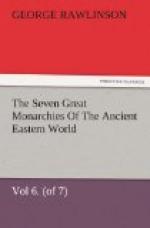Who were the Parthians? It is not until the Parthians have emerged from obscurity and become a great people that ancient authors trouble themselves with inquiries as to their ethnic character and remote antecedents. Of the first writers who take the subject into their consideration, some are content to say that the Parthians were a race of Scyths, who at a remote date had separated from the rest of the nation, and had occupied the southern portion of the Chorasmian desert, whence they had gradually made themselves masters of the mountain region adjoining it. Others added to this that the Scythic tribe to which they belonged was called the Dahse; that their own proper name was Parni, or Aparni; and that they had migrated originally from the country to the north of the Palus Maeotis, where they had left the great mass of their fellow tribesmen. Subsequently, in the time of the Antonines, the theory was started that the Parthians were Scyths, whom Sesostris, on his return from his Scythian expedition, brought into Asia and settled in the mountain-tract lying east of the Caspian.
It can scarcely be thought that these notices have very much historical value. Moderns are generally agreed that the Scythian conquests of Sesostris are an invention of the Egyptian priests, which they palmed on Herodotus and Diodorus. Could they be regarded as having really taken place, still the march back from Scythia to Egypt round the north and east of the Caspian Sea would be in the highest degree improbable. The settlement of the Parthians in Parthia by the returning conqueror is, in fact, a mere duplicate of the tale commonly told of his having settled the Colchians in Colchis, and is equally worthless. The earlier authors, moreover, know nothing of the story, which first appears in the second century after our era, and as time goes on becomes more circumstantial.
Even the special connection of the Parthians with the Dahse, and their migration from the shores of the Palus Mteotis, may be doubted. Strabo admits it to be uncertain whether there were any Dahse at all about the Mseotis; and, if there were, it would be open to question whether they were of the same race with the Dahse of the Caspian. As the settlement of the Parthians in the country called after their name dated from a time anterior to Darius Hystaspis, and the Greeks certainly did not set on foot any inquiries into their origin till at least two centuries later, it would be unlikely that the Parthians could give them a true account. The real groundwork of the stories told seems to have been twofold. First, there was a strong conviction on the part of those who came in contact with the Parthians that they were Scyths; and secondly, it was believed that their name meant “exile.” Hence it was necessary to suppose that they had migrated into their country from some portion of the tract known as Scythia to the Greeks, and it was natural to invent stories as to the particular circumstances of the migration.




